A trip to Hierve el Agua, El Arbol del Tule and Teotitlan del Valle
One Last Trip
Yesterday for my last day, Meghan and some other people from school and I rented a Suburban and a guide to take a trip around the Oaxaca valley. There were 6 of us, all women except for one man.
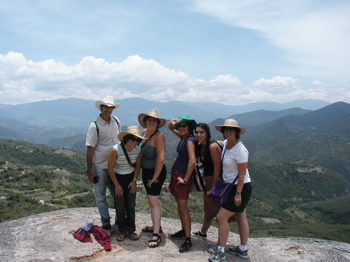
We first went to El Arbol del Tule, which had been a joke between Meghan and I because we were supposed to go there before and never did - we made a pact to lie and say we had because people were always asking us about it.
The arbol is said to be the largest tree in Latin America. It is a huge Mexican cypress with gnarled bark.
It is the former site of Zapotec rituals, and so of course there is a Catholic church right next door - the new "holy" site so the Zapotecs would start going there instead of worshipping at the tree.
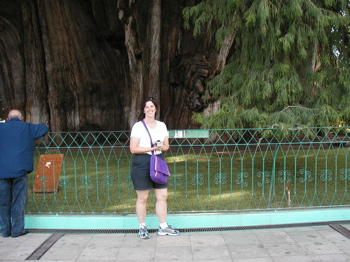
The fun part of el Arbol is that there are all these little volunteer guide kids dressed in green and white outfits. They will show you the figures hidden in the bark - a giant’s head, a deer, Jesus on the cross. They use little hand mirrors like laser pointers - they shine a spot of light on the place they are talking about.
The funniest figure is "The Madonna’s Butt" which indeed looks like a big butt sticking out of the bark.
Our second stop was the archeological site of Mitla, the post-Monte Alban capital of the valley.
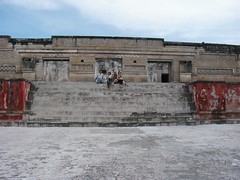
Mitla
It has big buildings with stone friezes in a style that looks very Greek. We had some laughs entering the three tombs, which have little tiny short doorways you have to duck-walk to get through. People kept smacking their heads on the stones.
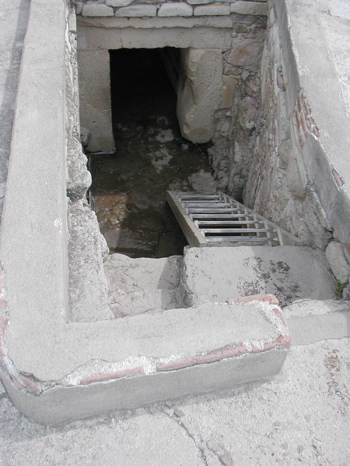
Tomb entrance at Mitla, with all the usual safety features
There was a market next door so of course us girls spent more time at the market than at the archeological site. Most of them bought some beautiful hand-loomed beaded bracelets for $4 but I skipped it.
We drove up through the mountains, gaining altitude. We went past tiny corn patches planted on almost vertical hillsides. There were lots of burros and we saw men driving horse-drawn carts. We were going to Hierve el Agua.
On the way, we saw a little tourist bus that was decorated for a fiesta, with garlands and flowers all over it.
Our tour guide Ivan explained that the fiesta was for the bus, since it was new. The people have a big party with music and food to celebrate their bus purchase. I just can't imagine anything like that happening in the US. People in Mexico really do like a good party.
Hierve el Agua is the site of a mineral spring. The water flows down to a pool and then over the side of the mountain. It is so full of minerals that it has petrified into huge stalactites that go hundreds of feet down.
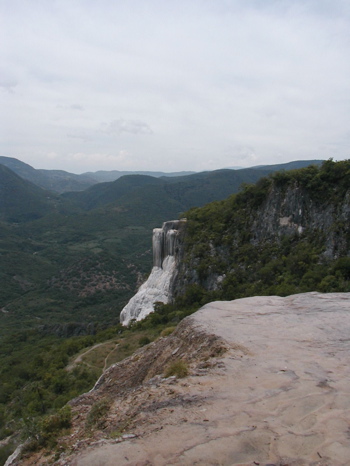
The petrified falls
To get up there you have to go on a toll road. There are two little boys sitting under an umbrella by the side of a road. When a car drives up, they stretch out a rope and collect ten pesos from each person in the car.
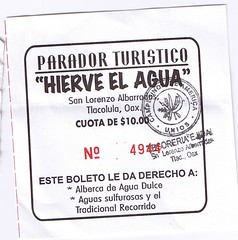
We got there and I saw these little tiny palapa huts selling food and a greenish swimming pool and I thought "Is this IT?" but you hike down a rocky volcanic path about another half mile to the natural mineral pools.
The access to the pools is hilarious - about a ten inch wide ridge with a 20 foot gradual drop on one side and a 10 foot drop on the other, covered in the mineral water that fills the pool...all wet, no handrails of course, totally dangerous.
Every day I marvel at how casually danger is taken here. Not enough lawyers, I guess.
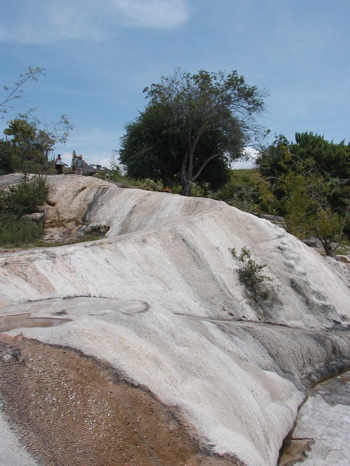
The path to the pool
The mineral pool is right on the edge of the mountain. The water flows over the edge and beyond there is a view of mountains for miles and miles. It is probably the most gorgeous natural spot I have ever been to.
We hiked down through native sages and ferns to the a view of the petrified falls and then back up for a swim. There were lots of families and other gringo students there, sitting in the sun and enjoying the water.
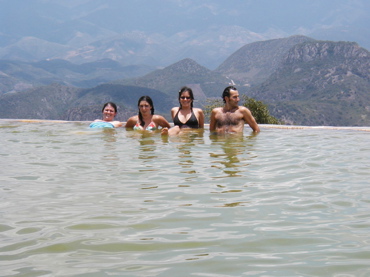
My classmates bathing on the edge of the world
We went back down the mountain, past little houses made of sticks and bamboo and palm leaves with pieces of fabric for doors.
There were lots of tiny mezcal factories, which are usually little concrete block buildings with tin roofs, with a big grindstone out front. An ox walks around the grindstone, crushing the mezcal piñas into a small pieces so they will ferment easier.
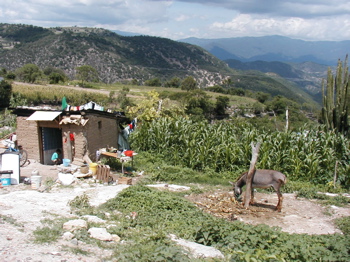
House in the mountains near Hierve el Agua
We went to a tourist trap for lunch. It was a combination mezcal factory and restaurant near Mitla called Rancho Zapata. They make a not very good mezcal there and have a small depressing zoo.
The zoo had a small anteater, ducks, horses, chickens and ostriches with their feathers picked out.
We got a tour of the mezcal-making process. Spiny agaves are raised and when their large, fleshy leaves are chopped after 8 years or so, what is left is called a piña because it looks like a pineapple.
The piñas are buried and roasted for a several days, then cooled above ground. Then the piñas are chopped in pieces, ground on the grindstone, and put in water to begin fermenting.
The resulting juice is distilled several times. We got to taste the first distillate, "aguaguardiente" fresh from the still - ¡ejole!
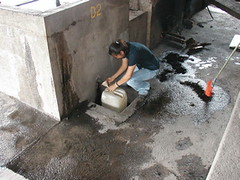
Quite strong. It burned for about 10 minutes after I drank it.
We also tasted their other kinds of mezcal - the silver kind, the gold kind, which is aged in oak barrels, the kind with the worm, and the cremas, which are flavored with fruit like passionfruit, coffee, pineapple, raspberry and coconut.
We ate an abundant and quite good lunch. I had chiles rellenos with chiles de agua, which are these local little tasty chiles, not the big whoppers they use back home. Other people got the big tourist platter, complete with pig's feet in vinegar.
Afterward, we stopped off at Teotitlan del Valle, a rug-weaving village. The first place we stopped at was closed with no one around except for a very pregnant dog.
The next place we went to was the home and workshop of master weavers Jesus Hernandez and Alicia Vasquez.
They gave us a fun demonstration of carding, spinning, dyeing and weaving the wool into their works, which are used both as carpets and as wall hangings. They had a lot of fun with us, showing us the strength it takes to card wool, and the skill it takes to spin and weave.
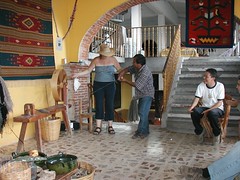
Jesus teaches Leslie to spin wool
They do the whole process themselves and it takes them up to 2 months to weave one rug, depending on the complexity of the design.
So of course, it being my last day, these being very nice people, and me just having finished tasting a bunch of mezcal, I bought 2. One is a gorgeous Zapotec design of stairsteps, representing the cycle of life, in all the reds made from cochineal dyes. The other is a classic local pattern of interlocking fish.
Alicia and Jesus were such nice people. The fish blanket had unfinished fringe, so I stood and watched them finish the edges, chatting in this beautiful language, Zapotec, as they worked with skillful, practiced hands.
Once we completed our purchases, they got out tiny coconut shell cups and more aguaguardiente and blessed us and our homes and said their happiness came from knowing their work was in our houses making us happy.
Yesterday for my last day, Meghan and some other people from school and I rented a Suburban and a guide to take a trip around the Oaxaca valley. There were 6 of us, all women except for one man.

We first went to El Arbol del Tule, which had been a joke between Meghan and I because we were supposed to go there before and never did - we made a pact to lie and say we had because people were always asking us about it.
The arbol is said to be the largest tree in Latin America. It is a huge Mexican cypress with gnarled bark.
It is the former site of Zapotec rituals, and so of course there is a Catholic church right next door - the new "holy" site so the Zapotecs would start going there instead of worshipping at the tree.

The fun part of el Arbol is that there are all these little volunteer guide kids dressed in green and white outfits. They will show you the figures hidden in the bark - a giant’s head, a deer, Jesus on the cross. They use little hand mirrors like laser pointers - they shine a spot of light on the place they are talking about.
The funniest figure is "The Madonna’s Butt" which indeed looks like a big butt sticking out of the bark.
Our second stop was the archeological site of Mitla, the post-Monte Alban capital of the valley.

Mitla
It has big buildings with stone friezes in a style that looks very Greek. We had some laughs entering the three tombs, which have little tiny short doorways you have to duck-walk to get through. People kept smacking their heads on the stones.

Tomb entrance at Mitla, with all the usual safety features
There was a market next door so of course us girls spent more time at the market than at the archeological site. Most of them bought some beautiful hand-loomed beaded bracelets for $4 but I skipped it.
We drove up through the mountains, gaining altitude. We went past tiny corn patches planted on almost vertical hillsides. There were lots of burros and we saw men driving horse-drawn carts. We were going to Hierve el Agua.
On the way, we saw a little tourist bus that was decorated for a fiesta, with garlands and flowers all over it.
Our tour guide Ivan explained that the fiesta was for the bus, since it was new. The people have a big party with music and food to celebrate their bus purchase. I just can't imagine anything like that happening in the US. People in Mexico really do like a good party.
Hierve el Agua is the site of a mineral spring. The water flows down to a pool and then over the side of the mountain. It is so full of minerals that it has petrified into huge stalactites that go hundreds of feet down.

The petrified falls
To get up there you have to go on a toll road. There are two little boys sitting under an umbrella by the side of a road. When a car drives up, they stretch out a rope and collect ten pesos from each person in the car.

We got there and I saw these little tiny palapa huts selling food and a greenish swimming pool and I thought "Is this IT?" but you hike down a rocky volcanic path about another half mile to the natural mineral pools.
The access to the pools is hilarious - about a ten inch wide ridge with a 20 foot gradual drop on one side and a 10 foot drop on the other, covered in the mineral water that fills the pool...all wet, no handrails of course, totally dangerous.
Every day I marvel at how casually danger is taken here. Not enough lawyers, I guess.

The path to the pool
The mineral pool is right on the edge of the mountain. The water flows over the edge and beyond there is a view of mountains for miles and miles. It is probably the most gorgeous natural spot I have ever been to.
We hiked down through native sages and ferns to the a view of the petrified falls and then back up for a swim. There were lots of families and other gringo students there, sitting in the sun and enjoying the water.

My classmates bathing on the edge of the world
We went back down the mountain, past little houses made of sticks and bamboo and palm leaves with pieces of fabric for doors.
There were lots of tiny mezcal factories, which are usually little concrete block buildings with tin roofs, with a big grindstone out front. An ox walks around the grindstone, crushing the mezcal piñas into a small pieces so they will ferment easier.

House in the mountains near Hierve el Agua
We went to a tourist trap for lunch. It was a combination mezcal factory and restaurant near Mitla called Rancho Zapata. They make a not very good mezcal there and have a small depressing zoo.
The zoo had a small anteater, ducks, horses, chickens and ostriches with their feathers picked out.
We got a tour of the mezcal-making process. Spiny agaves are raised and when their large, fleshy leaves are chopped after 8 years or so, what is left is called a piña because it looks like a pineapple.
The piñas are buried and roasted for a several days, then cooled above ground. Then the piñas are chopped in pieces, ground on the grindstone, and put in water to begin fermenting.
The resulting juice is distilled several times. We got to taste the first distillate, "aguaguardiente" fresh from the still - ¡ejole!

Quite strong. It burned for about 10 minutes after I drank it.
We also tasted their other kinds of mezcal - the silver kind, the gold kind, which is aged in oak barrels, the kind with the worm, and the cremas, which are flavored with fruit like passionfruit, coffee, pineapple, raspberry and coconut.
We ate an abundant and quite good lunch. I had chiles rellenos with chiles de agua, which are these local little tasty chiles, not the big whoppers they use back home. Other people got the big tourist platter, complete with pig's feet in vinegar.
Afterward, we stopped off at Teotitlan del Valle, a rug-weaving village. The first place we stopped at was closed with no one around except for a very pregnant dog.
The next place we went to was the home and workshop of master weavers Jesus Hernandez and Alicia Vasquez.
They gave us a fun demonstration of carding, spinning, dyeing and weaving the wool into their works, which are used both as carpets and as wall hangings. They had a lot of fun with us, showing us the strength it takes to card wool, and the skill it takes to spin and weave.

Jesus teaches Leslie to spin wool
They do the whole process themselves and it takes them up to 2 months to weave one rug, depending on the complexity of the design.
So of course, it being my last day, these being very nice people, and me just having finished tasting a bunch of mezcal, I bought 2. One is a gorgeous Zapotec design of stairsteps, representing the cycle of life, in all the reds made from cochineal dyes. The other is a classic local pattern of interlocking fish.
Alicia and Jesus were such nice people. The fish blanket had unfinished fringe, so I stood and watched them finish the edges, chatting in this beautiful language, Zapotec, as they worked with skillful, practiced hands.
Once we completed our purchases, they got out tiny coconut shell cups and more aguaguardiente and blessed us and our homes and said their happiness came from knowing their work was in our houses making us happy.

0 Comments:
Post a Comment
<< Home